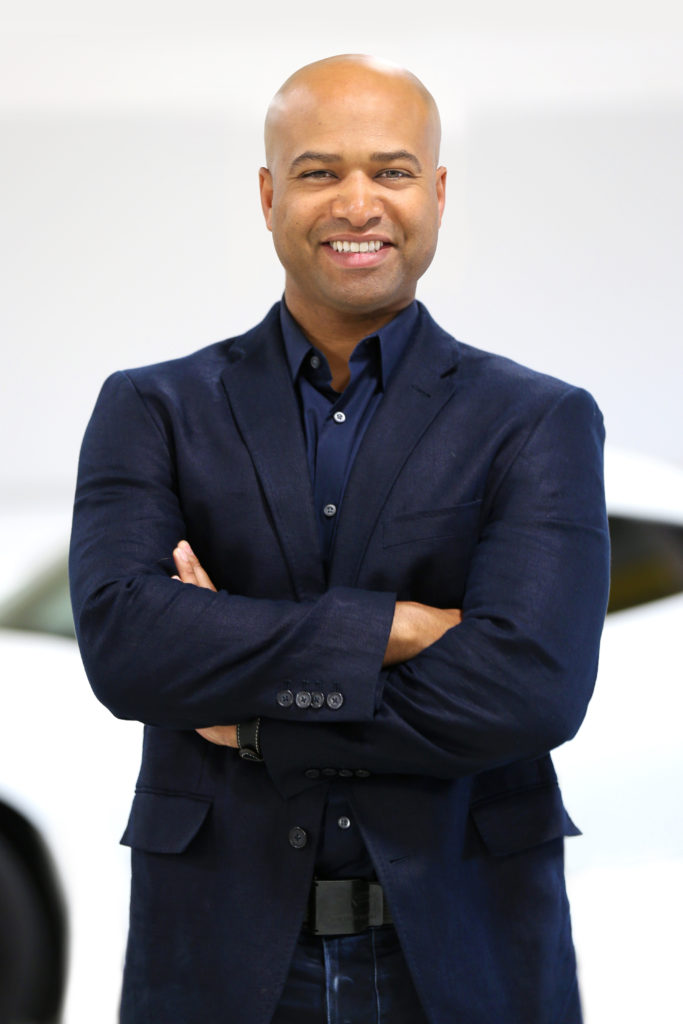
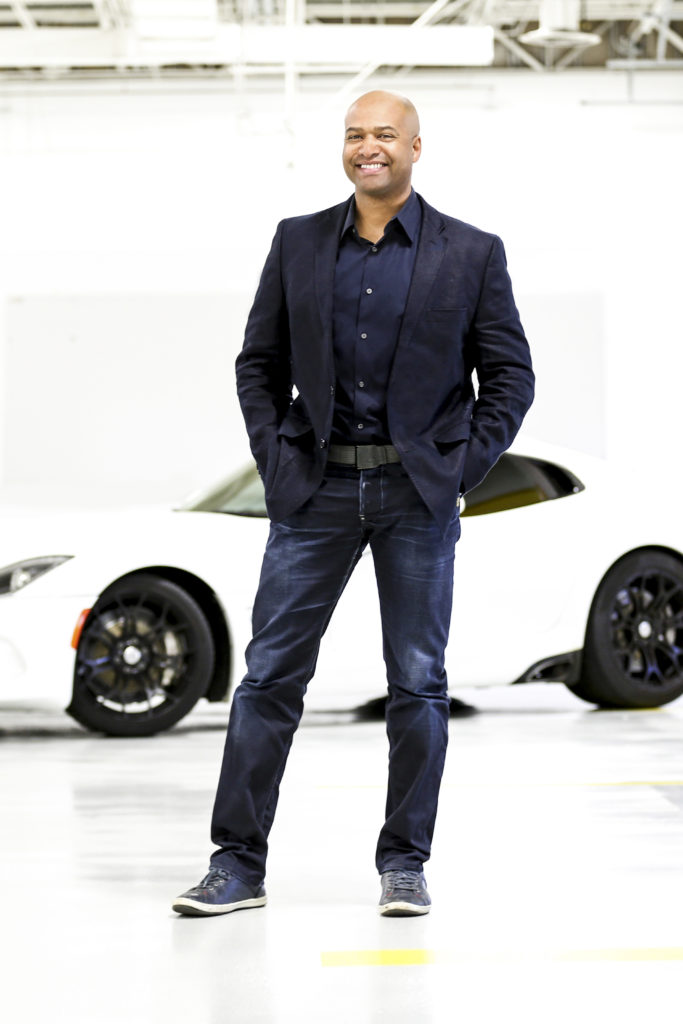
The Chrysler 300 was an icon when it was released in 2003 shortly after we launched our magazine Owners Illustrated in print the same year. This vehicle was designed by a legend in the industry, Ralph Gilles. I have had some interviews with him, and his storied career has taken him to Dodge CEO, and also the Executive Council at FCA, I also had to include him in this first collection of features from my career writing about the intersection of hip- hop culture and entrepreneurship since 2002.
Ralph was kind with his time in 2005 and also later in 2012. I will have the pleasure of meeting him several times since and he always is a great person to speak with. For this book on The Untold Stories of Success in pursuing the American Dream, I am including two of the interviews. With this feature, I want to showcase his evolution as a Business Executive and also illustrate the career possibilities for creatives coming from diverse backgrounds.
The triumph against all odds is always thrilling and inspiring to future generations. I have traveled to FCA headquarters in Auburn Hills and visited FCA brand Alfa Romeo in Arese, Italy. I can attest that anything is possible for those that believe in themselves. Ralph is a quintessential example of perfecting one’s craft.
When completed in 1998, the Merger of Chrysler and Daimler came with a lot of promise. One of the exciting hopes for the merger was the combination of German engineering with American muscle and great designs. In the area of great designs, was a young designer who was born in New York City with Haitian heritage. He is a graduate of the distinguished College for Creative Studies in Detroit. Ralph started a revolution that will inflame the urban car culture. In the process, he would generate billions in revenue for the partnership.
The 300 was based on the Mercedes Benz E-class components and featured several engine options from Chrysler, including the vaunted HEMI. The 300 was an American rear-wheel-drive sedan, and along with platform siblings, the Charger and Magnum dominated sales in the full-size segment. The 300 design still resonates and is among top sellers in the full-size segment to this day. Ralph has taken a variety of executive positions under FCA (Fiat Chrysler Automobiles), the new home for Chrysler.
He has served as president and CEO of Motorsports, SRT Brand, Dodge Brand, and he currently serves as Head of Design and has been named a member of the Executive Council. I have had several occasions to run into Ralph in Detroit at the International Auto Show and in other locations around the country. I also had a chance to interview him at a dealership in Virginia, where he drove a then Dodge Dart from Detroit with his nephew, and he had a chance to meet my son, now an engineer, and influence him also. Always the intriguing subject here is our conversation from our first interview in 2005.
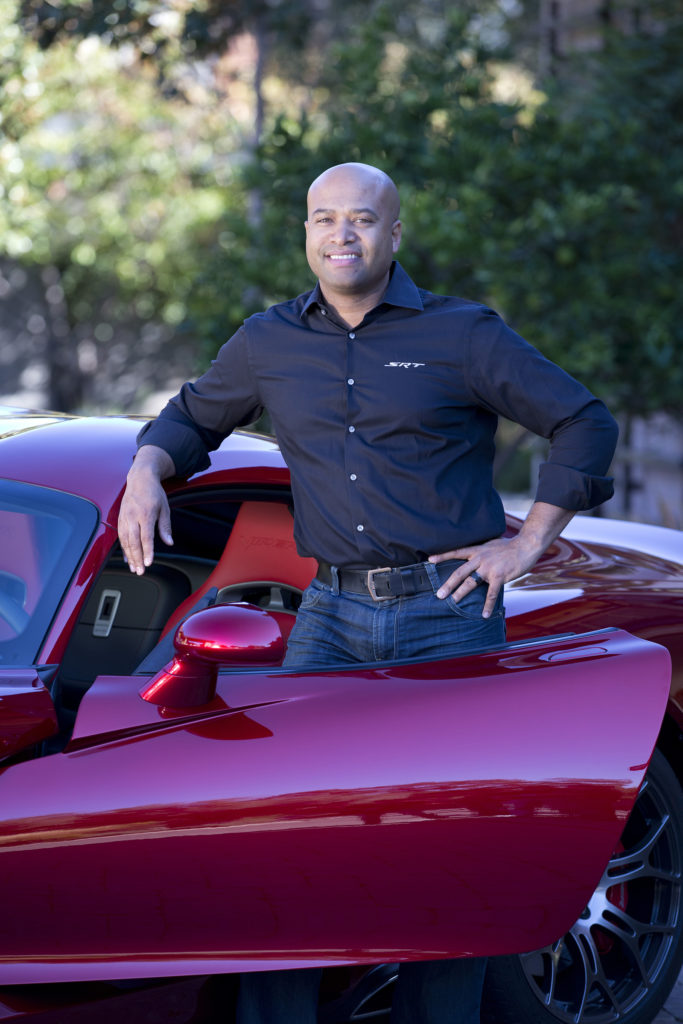
So, how did you get started?
Well, it’s, pretty simple. There’s about four design schools in the country. I went to the one that happens to be in Detroit, called, College of Art and Design in downtown Detroit. To get into that school you actually have to have some inclination already or you have to be an artist of sorts. I was always into sketching cars since I was a young man…literally. I never knew at the time that it was such a career as car designing.…I always thought it was more of an engineering degree, but it’s a much more artistic career than I thought. So it’s kinda cool because I don’t do too much math everyday. There’s a lot of industrial design schools, but there’s only a really, really limited amount of automotive design schools. And those are more like vocational schools, where you’re pretty much – I mean they are credit colleges, but the minute you’re in, you’re in car design. It’s very concentrated.
So how long have you been with Chrysler?
Since 1992, so approximately 13 years now.
So, what was the first car you were involved with?
The first car I was involved with was a concept car, actually a few concepts, called the Dodge Intrepid ESX. It was a hybrid electric. It was actually a precursor to the last generation of Intrepids. So it was kind of a fun project. I did mostly interiors at that time.
So when was the decision made, design wise, to try to combine, I guess the LHS, the Intrepid, 300M, and Concorde, to all be under the 300 design?
Well, we don’t think that way, actually. We don’t combine ideas. We like to call it more heritage. We have our own heritage that comes from 50 years ago and obviously every time you make a car, it’s part of history. Some people want to try to tie it in. You know, we don’t really mix it all together. That’s a misconception I think got out there. But the decision was made to do this kind of car several years ago. If you’ve been paying attention to our concept cars, you can do some research, you can find that we’ve been doing kind of premium Chrysler concepts for the last ten years or so. The one which is probably closest to the 300, was called the Chrysler Chronos. So there’s a lot of rich heritage. Our company was striving to move the brand forward and upwards. So these concept cars were a way of exercising this you know, trying to find a formula. The 300 borrows a little bit from the Chronos in terms of the front end, there’s some of that magic there. But that’s where the inspiration comes from.
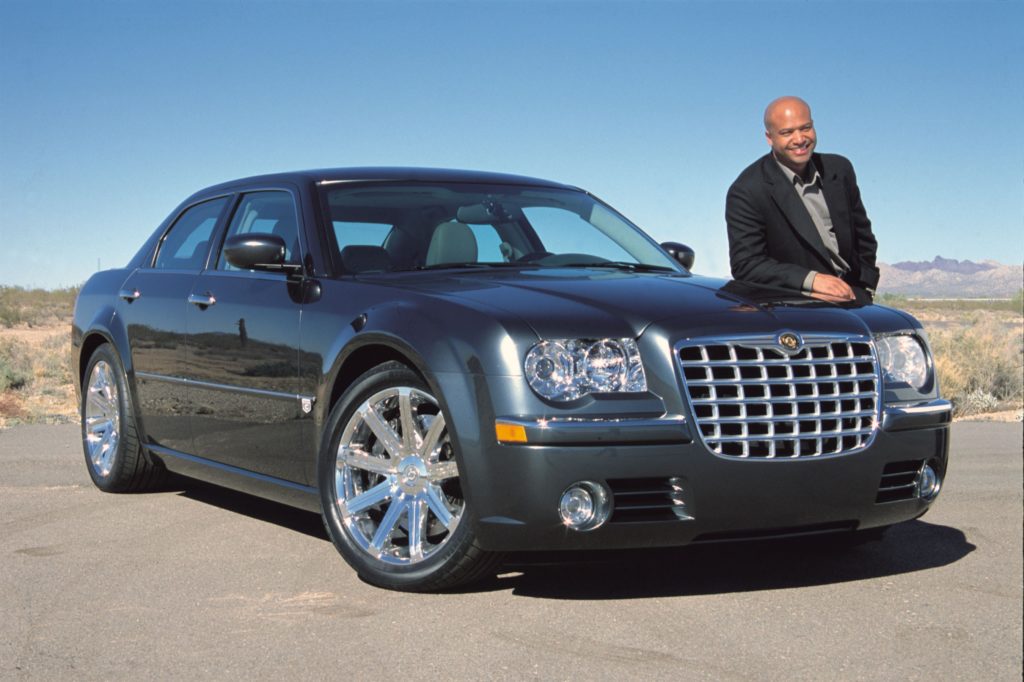
Actually, when I look at the 300 design, I can also see a lot of the heritage of the original 300.
Matter fact, when that car was being clayed up, in the very, very beginning, we had a 300, a C300, a 1955 C300 in the studio, just for inspiration. I mean, to remind everyone that we were trying to create something really special here. Not necessarily to aid anything, just to kind of get the mood in the right way.
Of course. So what was the inspiration behind the design?
Well, there’s nothing less than a few things going on. First of all, we wanted to create what we call a noble proportion. We wanted the car to be, not a typical sleek sedan. We wanted to get back up to, first of all, getting the car to feel more upright. Basically we lifted the passengers about 2 inches. So they sit a little more proudly in the car, they see down the road better. And people are used to that now; they drive a lot of SUVs, a lot of trucks. So, it’s not imperative for them to go back to a low-slung car. We wanted to create something a little different. And that drove a different aesthetic. It drove a totally different look to the car. We tried doing the sleek looks over the package. And it just didn’t look good. We started to look at more upright looks – and when I say “upright” I mean the grille stood up, the windshield’s more vertical. That kind of silhouette worked much better with this new package that we’re gonna do. Not to mention the HEMI. We knew from day one we were gonna put the “HEMI” in the car, and that’s a good-sized engine. It requires quite a good-sized front end to carry that engine. So then also…
You need a longer hood.
Exactly. So that dictated a certain look. Then once we got going, we realized we have something that looks rather classic. You know, we have a very classic proportion, which resonated extremely well with people, when we went to early research.
So, was there any inspiration from the Bentley?
Not really. We never had a Bentley in our studio and said, “let’s look at that,” you know what I mean. What the irony is, when you come up with the proportions, I mean if you look at a Bentley frontally, it carries five people, it has a big V8 engine, the people sit up right. So all of a sudden, yeah, you have a similar overall silhouette. But I dare you if you put the cars next to each other, there’s nothing in common. Absolutely nothing. But it was one of the problems when we did the research and people said the same thing. The Bentley is easily a 20% bigger car than ours in every measure. It’s much longer, much taller, much bigger. I mean, it’s just the presence. I think that’s a beautiful compliment because I think the 300 definitely has presence, and presence is what a Bentley has, that’s what a Rolls-Royce has. When you see one of those rolling down the road, you’re like “Oh my gosh, there’s somebody important in that car,” you know what I mean? And the 300, at a wonderful price point, has that same respect. And that’s the magic of the car. For $25,000 to $30,000 you can feel like royalty.
Are you guys designing a convertible for the 300?
I cannot talk about future products. We get asked that a lot, but we are always cooking up stuff.
Of course. There was a convertible at the [NAIAS 2005] show, however.
Yes, there was a four-door convertible done by an outside company, called America’s Specialty Cars. They did a wonderful job. We’re very, very happy they did that. We think it’s a complement to our vehicle. But we have no association to that project.
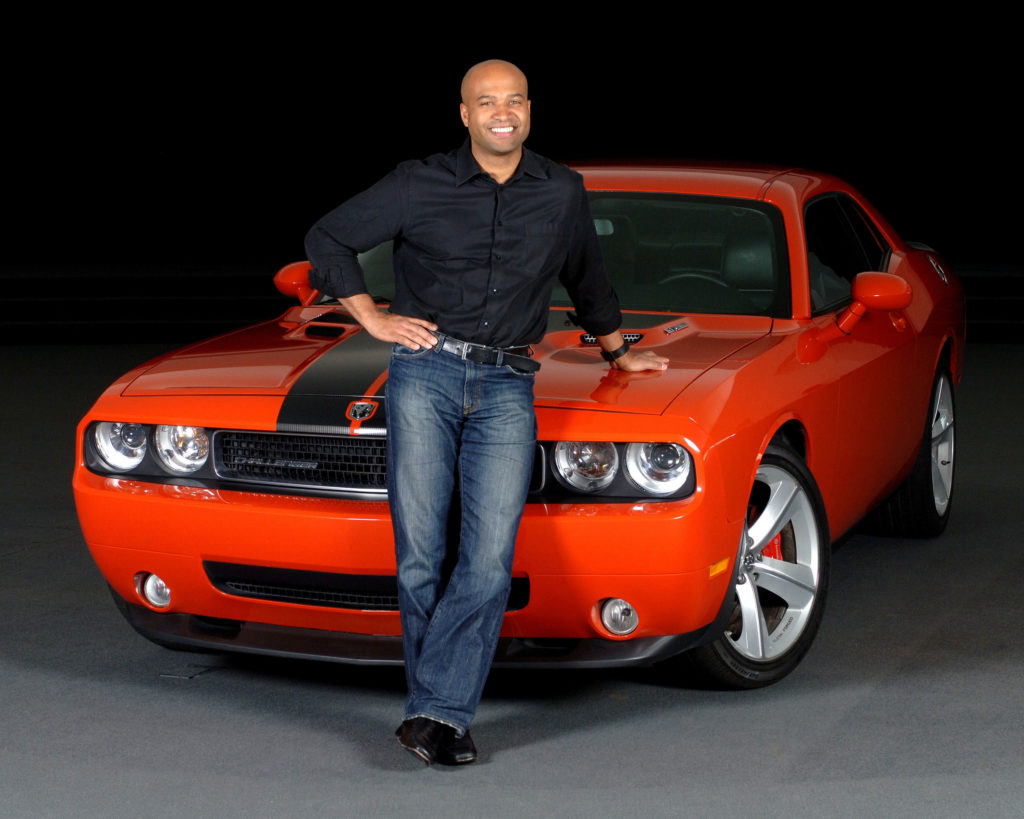
How much, do you think, does the urban aftermarket culture influence what you’re doing?
Well, I like to put it this way: I’ve been asked that question a few times. But I’ve been thinking about this for a few months and I think what happens is we at Chrysler, we’re such enthusiasts ourselves. You know, we’re car enthusiasts, too, just like everybody else. And we think we have a like-mindedness to those guys. And I myself, you know every time I get a car, I put wheels on it. Every time—I like to customize a car. And at Chrysler, I would argue that our cars leave the showroom floor already looking somewhat tricked out, you know what I mean? So there’s a little bit of that spark already, just in the nature of the car. And when we did the 300 we knew we’re gonna come out with 20” wheels, we have them now on the SRT, going into production in a few months. So we had to kind of leave that room in there. And then, the minute you do the wheels, you’re just like “uh oh,” we left them enough room to do that. (add wheels) I talked to Myles, owner of Dub Magazine. That’s the one thing that started the whole craze. We realized, this is one of the only cars – the only other car you can put 20s and 22s on is the BMW 7 series. There’s no other passenger car that can fit wheels that big. So it’s like, he said “this car is gonna blow up”. And he was right…it did. So, again, I think it’s that we’re more like-minded. We enjoy, and love cars so much that it just comes out in the product. People that love cars gravitate to cars like that. So, it’s a cool relationship.
I know that it does have some components from the E-Class. How much of that is that…
Yeah, and again, that’s another huge misconception about the car. That’s great that you would think it shares with the E-Class, but the E-Class is a whole different size. We have a much longer wheel base, a different track. There’s only, the transmission, and the steering column I would say are verbatim pieces from the E-Class. And actually, those are made in America. We want to re-develop because it’s good, you know what I mean? The rest of the car is more of the philosophy. Mercedes has 30-40 years of rear driving experience. And they’ve consulted us and helped us develop the best rear drive we could, but there’s no parts that are shared. It’s just the philosophies are the same, you know? Our parts have to be different dimensions, different materials, because we have a bigger wheel and tire than they do. Different vehicle weights, different power components. It’s more of using the experience of Mercedes and making sure we get it right the first time than using actual parts.
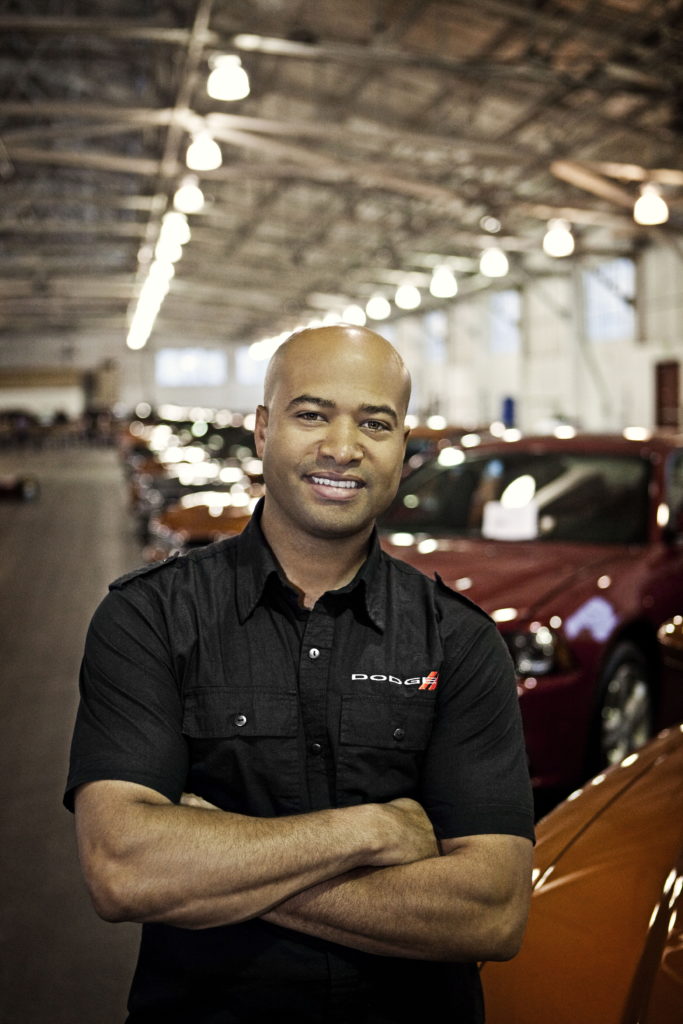
OK, that’s really interesting right there, because, it’s like having the best engineers consult and then to be able to offer these great technologies to people in an affordable way.
Precisely. And that’s really what merging is all about. That’s what we’re supposed to be doing as a global company. That is what Daimler Chrysler’s advantage is over any other manufacturer. Our engineers, some fly over to Germany and others fly from Germany to the US. And we’re constantly trading ideas, because it’s some things they’re good at, and some things we’re good at. So, merging turns out to be a great thing.
Going from there to the Magnum. Which, I guess is the same L…what’s the platform?
LX Platform.
LX Platform? I mean, one thing about the Magnum it’s like totally revolutionized the station wagon. I mean, it’s like now wagons are cool.
You know, I remember talking about this car, and that car’s really special to me. Because honestly it was a little bit of a struggle. The American station wagon has really been a forgettable thing, you know what I mean? So for us, you know I remember being in a meeting, and talking to my guys and saying, “trust me on this one because we’re gonna do this one with love. We’re gonna really love this thing. And make it cool.” You know… granted, it has 71 cubic feet of space; it’s not the biggest wagon in the world. And that was never the point. The point was we wanted it to be the coolest wagon in the world, and I think we did that.
What was the inspiration and what was some of the design philosophy behind that?
Well, again the design philosophy was to have something that was more steady. Ok, the typical wagon formula is almost like a shrunken down SUV, like a box basically. And we wanted to make the car have some drama. The wagon in our mind was really an alternative to a sedan. A lot of people in our situation, a lot of young men in my studio that are just having young families, they kind of need a car that does everything. They like the handling of a sports car, they like the space of an SUV. They like, you know, the functionality of putting the seats down to carry big stuff once in and go to Home Depot or whatever. So, this car is really a result of, “hey, what would you do if you had a clean sheet of paper and you needed something that had all these attributes?” And a wagon was like the perfect formula. So, it combined functionality and style like no other. That was really what we wanted to do. And we love it! Have you seen the brand new SRT-8 Magnum that was shown?

I was actually gonna ask you about that because I love the wheel package.
Oh, yeah, that came out of our studio. It came from an enthusiastic bunch of guys saying, “why not?” You know, no one’s ever done that – only the Germans have done that, and again, that’s at twice the price of us. So we’re offering a very athletic family vehicle. It’s a really cool combination.
I guess traditionally, the Charger has always been a 2-door. I guess a lot of people remember it from The Dukes of Hazzard. So what’s the philosophy?
Well, actually, the Charger’s not necessarily about doors. And I guess we expected a little bit of angst when we showed the car with 4 doors. And I think as time goes on people will get it. We already have some special things worked up for the car that you’ll see very shortly that will underscore the car’s attitude. I have nothing but positive thoughts about this car. I think it’s gonna blow up just as well as the others. Again, it’s all about the attitude. It’s what I would call a 4-door coupe. It’s got a very rakish roof, it’s got a very rakish body/side, absolutely menacing front end – A very athletic body. You have to see it in person, just like the 300; you gotta be on the highway and see these things driving by you, and then people will be like “Ok, I got it now.” So, I’m pretty confident about that car.
Will there probably be an SRT?
Perhaps, perhaps.
So what is your exact role? Like in your job description?
I call it director. It’s actually a very accurate title. It’s very much like a movie director. Actually, I don’t sketch anymore because I’m in management. I coordinate the events, I pick the sketches, I help manage the execution, I deal with engineering, deal with marketing, and deal with public relations. Kind of like the hub for a vehicle. I manage all the requests from engineering and make sure it doesn’t compromise the design. If I need to fight for something, I go to bat for it, whatever… because I’m really directing the execution and the creation of a vehicle. But I have a great team of designers and a great team of engineers. So I’m part of a vertical team of easily 3000 people. So think of it that way. No one person puts a car together.
So what advice can you give to young, aspiring designers?
Honestly, my advice to them is first of all there’s no such thing as barriers. I thought there would be when I first started this business, but there really aren’t. If anything, your color makes you that much more noticeable. It can be an advantage in some way, because it’s missing. There really isn’t enough color in the industry, and I think that should happen. But it starts at the school level – people getting into the industry in the first place. Anything is possible, especially in this country. You just gotta want it. There’s financial aid, there’s all kinds of mechanisms to go around the financial issues that’s in the way. It’s really about dreaming and going for it!
OUR SECOND INTERVIEW
(After some small talk and catching up)
RG: …It’s fun to now be on a design side. I’ve been in design like all along but now working on the SRTs which most of them are Dodges right now, it’s exciting to kinda take that…SRT is like the hot sauce so to speak. It takes what’s already cool and makes it a little hotter.
OI: But deeper into that and you’re talking about the entrepreneurial spirit because in my purview Dodge Brothers also had a history with Ransom Olds who’s really like the first guy to kinda like set the foundation of American manufacturing.
RG: Yeah, they did a lot for Ford. They did a lot for – ‘cause they were basically parts suppliers. They used to do the very precise gear sets, a lot of stuff that went into most of it. They were actually huge suppliers. They almost got too powerful because if they stopped shipping parts they could shut down Ford overnight, you know, so that got everybody nervous and that’s when they realized they had to maybe make their own cars not just supply parts so they kind of understood the value from the beginning – how important quality is, how important innovation is, taking – you know managing costs for innovation not just cutting corners so to speak so all that’s part of who they are and I think who we are today.
OI: But it’s such a humble beginning because they really were like craftsman in engines – like they really built these parts and it’s like this family and then it grew but it’s like – and I say that because your job being a designer then running that brand and actually bringing that brand back – I mean you oversaw the launch of the Charger, right, the new Charger integrating that into Fast & Furious 5. I think we ran into each other in New York about that…
RG: You know the thing that’s different about Chrysler now is how well the management team works, right. So yeah, we have a lot of fun so you’ve got the – What Sergio’s done is he put a lot of passionate people together and they’re all running slightly different parts of the company. When you group that all together the energy’s incredible. It’s like taking a few suns and putting them in one place. The creativity of our marketing team combined with the creativity of the design office and the Dodge brand and all that and we do some cool things like the movie stuff. Olivier has done a great job connecting to the movie industry which allows us to put product placement in a way that makes the cars superheroes, you know. Like the Fast Five was incredible, watching our cars kind of be heroes, but we also blended not just SRTs but you know Charger police cars. We had Jeeps in there. We had a lot of stuff in there. It’s a very clever way to show the cars in a heroic way but also show them in a different way. Normally Fast Five has all been about import cars. This one was about American cars and here the Americans come in and get some respect. You know what I mean. So that was pretty neat so it takes again a company willing to take risks and do things a little differently and you end up standing out when you do that.

OI: So now contrast that because you’ve actually been through three ownerships You were there when Mercedes then Cerberus and then Fiat. Talk about that transition and contrast what’s going on now to the evolution of your start especially working the LX platform.
RG: Yeah, I mean I think what I like that’s happening now is the product is king. At times in Chrysler’s history product’s been king – you know, back in the early 90’s and the “cab forward” days we were really innovating and really starting to take market share and actually create segments. You know, we innovated a lot of segments – the minivan, the PT Cruiser, the Pacifica…the Durango so we were kind of going after these kind of white spaces in the market. So we kind of put all our energy in that and then obviously we had some success and Mercedes came along…What I find that’s happening now that I like is the company’s very focused on, I would say, perfection, right, trying our best to be mining every part of the business, not just the styling or the packaging of the car but the way you treat the customers, the way that cars are delivered, how you make them, when you make them. We have no problem shutting down a plant if we have to until the car’s right, so we’re not about piling up the lots with cars. It’s about when they’re ready, they ship, you know, so the full value stream of car production from the minute it’s a sketch, picking the best sketch possible, doing the benchmarking, being humble about it, executing the best you can, promoting it really well, having some fun with the marketing and then take care of the dealerships. We’ve touched – you know, Sergio and the rest of the team have touched every part of the business so now what you’re seeing and the reason a lot of our sales has been pumped up is because it’s all starting to pay off. So a lot of work, I would say the last three years the company has invested big time in the fundamentals, you know fixing the fundamentals, getting the right talent in place, promoting it well, and doing the right things and I think the market is speaking with their dollar.
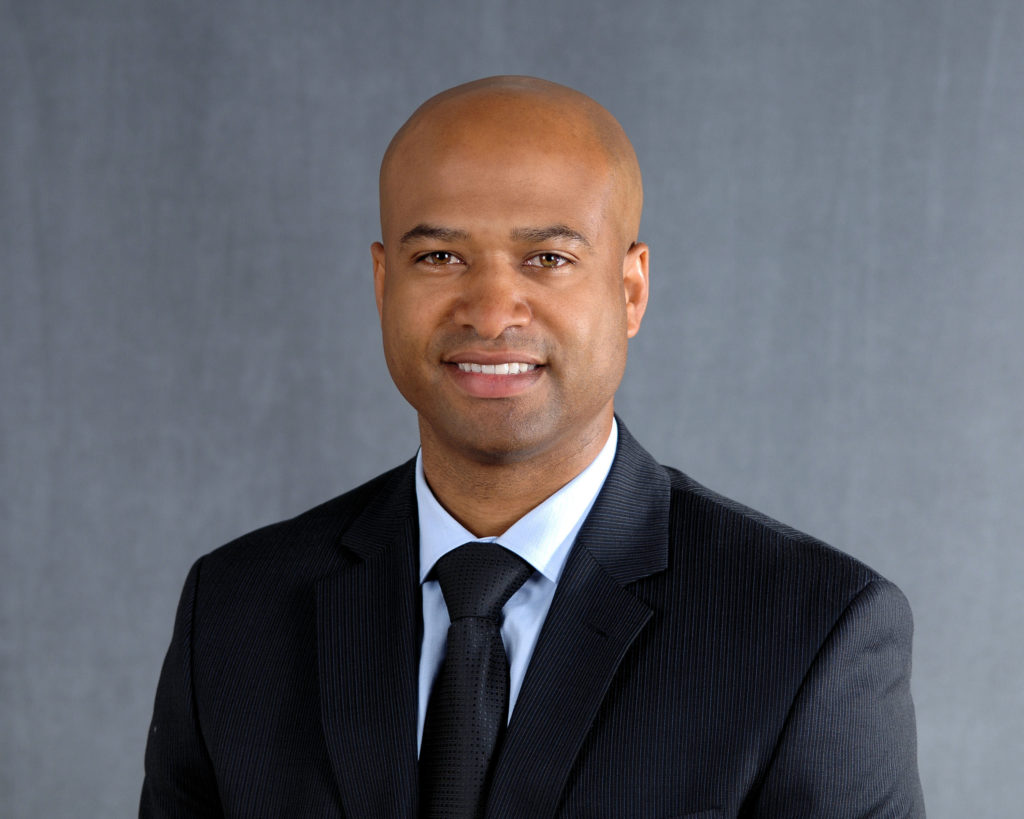
OI: Now speaking about that, and what brought sort of like your marquee, your touchstone is building that LX platform, the 300, the Charger, the Magnum. I think at the peak you guys were doing almost 300,000 in volume with those three cars?
RG: Yeah, almost.
OI: Almost? Now what’s fascinating now is that with the Charger and the 300 you’re kind of almost halfway there, right, with volume. You’re doing almost about 15,000 sales a month?
RG: Yeah, we’re doing pretty well. Those cars are picking up. It took a while because people look at cars that size and they usually think – or they right them off. One of our biggest issues in the past was fuel economy or perceived fuel economy. They look at a big car they expect it to get a certain amount of fuel economy and what our engineers have done is been able to, with the magic of the eight-speed and the Pentastar you can get 31 miles per gallon in a Charger or a 300 which is unheard of, you know, in that class, at that price to have that much technology.
OI: I mean a car with that weight.
RG: Yeah and it’s a safe car. It’s a very comfortable car. It’s got world-class levels of technology and quietness so people – you know the word of mouth, you know, dealers go oh my gosh, when you really think about. You know the marketing is starting to take hold as well. And of course, the results are coming. So that’s been truly on virtue we have. We haven’t done anything unnatural, just putting the best product we can out there. And Americans love their cars. They love big cars. They love some room. So what we tried to do is break the code on it, find a way to make it efficient, beautiful, quality and it’s right now, as we stand the 300 is the highest rated car in Consumer Reports that the company makes. So at a 83 score, it’s well respected even by a third party.
OI: Now I mean just speaking about that though and it’s quite fascinating that you’re speaking about that. Your product planners are doing such an incredible job because I’ve test driven a lot of iterations of that car and I’m like here is a car getting 290 horsepower, 8-speed automatic, 31 miles per gallon – you’re getting 31 mpg’s on a car that size and then 27 mpg’s with an all-wheel drive system at a sub-$30,000 price point to begin with. I’m almost like well, how do you guys pull that off? How do you sell an 8-speed ZF? I mean this is the same type of transmission you’ll find in the high Audi’s and the high-end BMW’s I mean these are – you’re not sourcing from cheap.
RG: I’m glad you’re saying that because that’s what’s happened lately, people are willing to invest in the product. If I can get the product right and kind of they will come. So we’re not shy to put the best technology we can get. The ZF 8-speed is an awesome piece of engineering. That’s what it takes to make the cars world-class. That’s what we’re focused on. So really hats off to our powertrain team. They did a great job.
OI: Now obviously with the SRT brand, the Bumble Bee editions, 470 horsepower, 6.4 – so talk about…how you now build upon that like you’ve got the fuel efficiency which is moving the volume, getting people in the dealership, sub-$30,000 price point but then now you’re able to say “Here is that real muscle.”
RG: So here we are today at Moparpalooza so you’re seeing firsthand what passion can equal. A lot of SRTs here but a lot of other Mopar products here and Chrysler Group products. You know we have Jeeps. We have Chryslers, a few Rams as well and obviously some SRTs so I think you know passion even back in the day. In the 70’s people thought – early 70’s – passion would go away. Everyone was worried about getting the cars as small as possible, fuel-efficient but we’re finding technology has enabled it now so you can have 470 horsepower and still get 21-23-24 miles per gallon so the magic is finding a way to kind of have both coexist right now so – and still have fun. And we built cars that are passionate, one of the few – like Charger to me, an SRT Charger has no competition. I can’t think of another car in its class to compare it to. I really can’t. So we offer something very unique that solves a problem for someone who’s an enthusiast, has a family, likes to go fast, wants something different and wants it bright yellow and we make that. So I think it’s really – that’s one of the things I love about this company is we have these delicious brands and we can do all of this great stuff. The Jeep brand is a great example of how much fun you can have with a vehicle and I see them all the time with the doors off, with the roof off, people loving it. Then you have cars like the Grand Cherokee SRT8 which is kind of the do-all, sports car, super car, SUV, physics-defying machine so it’s just – for me as a designer it’s just a pinch-myself situation to work with a company and still make cool cars.
WHERE ARE THEY NOW?
Ralph currently serves as Head of Design and is a member of the Executive Council.
